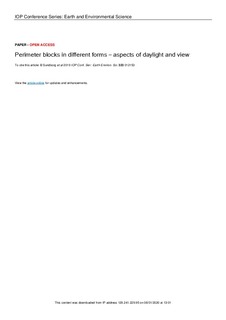| dc.contributor.author | Sundborg, Bengt Åke | |
| dc.contributor.author | Matusiak, Barbara Szybinska | |
| dc.contributor.author | Arbab, Shabnam | |
| dc.date.accessioned | 2020-01-09T07:26:01Z | |
| dc.date.available | 2020-01-09T07:26:01Z | |
| dc.date.created | 2019-12-06T20:43:30Z | |
| dc.date.issued | 2019 | |
| dc.identifier.issn | 1755-1307 | |
| dc.identifier.uri | http://hdl.handle.net/11250/2635431 | |
| dc.description.abstract | The perimeter blocks in cities are usually rectangular and follow the streets. The buildings are mostly of similar height within each block. However, perimeter blocks can be developed in many various forms. Geometric options such as chamfered corners, varied building heights and different positioned openings in a broken perimeter block are analyzed in this paper regarding the aspects of views and daylight in city planning. The choice of evaluation criteria is based on scientific discourse in the field of daylighting. As in the new European standard, “Daylight in Buildings”, the following three parameters are included in calculations: solar radiation, daylight level and view out. Computer-based daylighting simulations and calculations of view parameters are performed for different designs of the perimeter blocks with equal density, FAR = 1.33. The simulations have been carried out for Stockholm. That means roughly the same shadows as in Oslo, Helsinki, Tallinn, St Petersburg and Anchorage, all close to the same latitude (60!N). In lower latitudes, e.g. Southern and Central Europe the shadows are shorter. Nevertheless, the ranking of the alternatives will be similar. This study confirms that geometrical changes can improve the conditions for views and daylight in the perimeter blocks. The advantages in the tested urban design alternatives are considerable compared to the perimeter block of the standard type. | nb_NO |
| dc.language.iso | eng | nb_NO |
| dc.publisher | IOP Publishing | nb_NO |
| dc.rights | Attribution-NonCommercial-NoDerivatives 4.0 Internasjonal | * |
| dc.rights.uri | http://creativecommons.org/licenses/by-nc-nd/4.0/deed.no | * |
| dc.title | Perimeter blocks in different forms - Aspects of daylight and view | nb_NO |
| dc.type | Journal article | nb_NO |
| dc.type | Peer reviewed | nb_NO |
| dc.description.version | publishedVersion | nb_NO |
| dc.source.volume | 323 | nb_NO |
| dc.source.journal | IOP Conference Series: Earth and Environmental Science (EES) | nb_NO |
| dc.source.issue | 1 | nb_NO |
| dc.identifier.doi | 10.1088/1755-1315/323/1/012153 | |
| dc.identifier.cristin | 1757787 | |
| dc.description.localcode | Content from this work may be used under the terms of the Creative Commons Attribution 3.0 licence. Any further distributionof this work must maintain attribution to the author(s) and the title of the work, journal citation and DOI 10.1088/1755-1315/323/1/012153. Published under licence by IOP Publishing Ltd | nb_NO |
| cristin.unitcode | 194,61,55,0 | |
| cristin.unitname | Institutt for arkitektur og teknologi | |
| cristin.ispublished | true | |
| cristin.fulltext | postprint | |
| cristin.qualitycode | 1 | |

